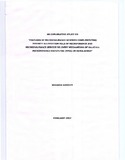| dc.contributor.advisor | Hakim, M. A. | |
| dc.contributor.author | Siddiky, Shakera | |
| dc.date.accessioned | 2010-09-26T04:49:55Z | |
| dc.date.available | 2010-09-26T04:49:55Z | |
| dc.date.copyright | 2007 | |
| dc.date.issued | 2007-02 | |
| dc.identifier.other | ID 04262010 | |
| dc.identifier.uri | http://hdl.handle.net/10361/227 | |
| dc.description | This dissertation is submitted in partial fulfillment of the requirements for the degree of Master of Development Studies, 2007. | en_US |
| dc.description | Cataloged from PDF version of dissertation. | |
| dc.description | Includes bibliographical references (page 45 - 46). | |
| dc.description.abstract | The main objective of the study is to explore the features of a number of existing micro insurance schemes complementing poverty alleviation role of microfinance and microinsurance service delivery mechanisms followed by selected number of Microfinance Institutes in Bangladesh.
The analysis was based on primary data collected through personal interviews with seven MFIs having some sort of microinsurance products for members and non¬members. The data for the study was collected from March 2006 to June 2006.
Explorative research and qualitative analysis were used to achieve the study objectives. The major findings of the study are (1) All microinsurance products are mandatory and complementing either saving or loan products offered by the MFIs (2) all the MFIs follow provider model of microinsurance service delivery, that means MFIs provide the care as well as take charge of designing insurance products, collect premiums, review claims, handle payments etc. using the existing structure (3) the predominant reason for introducing microinsurance scheme is to remove financial barriers of the poor to mitigate risk (4) most of the schemes are offered to the existing loan and saving beneficiaries and health insurance is offered to existing groups and community people (5) need of adequate underwriting, actuarial and business planning expertise is acute among the MFI (6) benefit packages cover a number of IGA and Non-IGA project related risks (7) administrative costs of claim and reimbursement are kept to a minimum (8) MFIs have various measures to control financial risks of particular importance are moral hazard, adverse selection, cost escalation, fraud and abuse.
Based on the finding the main challenges of offering microinsurance products to the target beneficiaries are a) To do full cost recoveries of the new financial scheme in short term b) To keep premiums affordable and flexible coverage c) Need for qualified human resource d) need for technical expertise and e) absence of reinsurance. Partner-agent model has been suggested to overcome the challenges faced by the MFIs. A path has been recommended at the end to design and introduce sustainable and viable insurance scheme based on the technical capacity of the MFIs. | en_US |
| dc.description.statementofresponsibility | Shakera Siddiky | |
| dc.format.extent | 54 pages | |
| dc.language.iso | en | en_US |
| dc.publisher | BRAC University | en_US |
| dc.rights | BRAC University dissertation are protected by copyright. They may be viewed from this source for any purpose, but reproduction or distribution in any format is prohibited without written permission. | |
| dc.subject | Developmental studies programs. | |
| dc.title | An explorative study on Features of microinsurance schemes conplementing poverty alleviation role of microfinance and microinsurance service delivery mechanisms selected microfinance institutes (MFIs) in Bangladesh | en_US |
| dc.type | Dissertation | en_US |
| dc.contributor.department | BRAC Development Institute, BRAC University | |
| dc.description.degree | M. Development Studies | |

